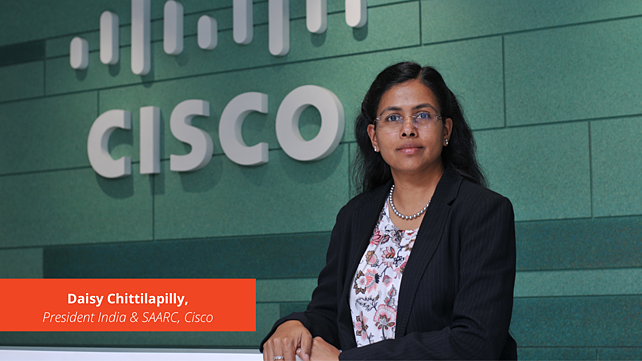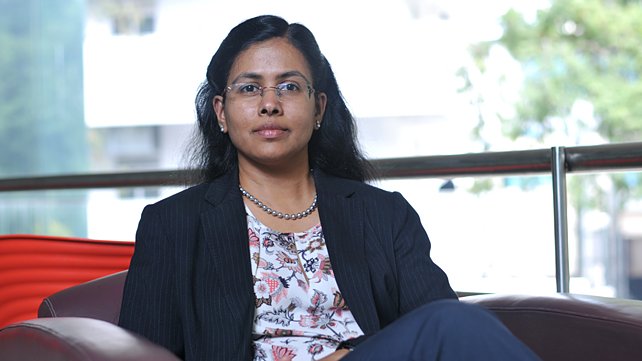
With over 25 years of work experience, Daisy Chittilapilly is currently serving as President, Cisco India and SAARC. She is responsible for strategy and sales, operations, and investments to drive long-term growth in the region. In addition, she spearheads Cisco’s digital transformation agenda, aligning the company’s offerings and ecosystems to emerging opportunities in digital and helping digitally enable organisations across industries, including the mobility sector.
How do you view mobility in the context of the global megatrends of connected, autonomous, shared and electrified, and the numerous opportunities that we see appearing on the horizon?
Autonomous, connected, electrified and shared conversation related to mobility has never been more interesting than it is now. This is particularly because of the world we are already living in and the world we will live in. A great degree of automation and autonomous conversations are definitely on the rise, as Level-3 and Level-4 autonomous vehicles will be widely available by 2023, which is not a very long time away. So that’s the one interesting thing to watch for.
Another interesting aspect to note is that automakers may not rely on auto sales for future revenue streams in the future. The traditional business models are getting fast outdated, and business models around sharing revenue streams from partners are monetising vehicle data. All of these are becoming interesting business models for people, who were traditionally relying heavily on vehicle sales.
In India, we have also seen trends expanding beyond car sharing. On the other side, a whole new ecosystem is developing around the electric charging ecosystem. There are many things emerging in mobility as a service space. These transitions are good for the industry and also useful for broad set of stakeholders, who are either consumers or participants in this economy and mobility industry.

Tell us about how digital solutions are shaping the transformation of the transportation sector in this scenario?
Technology has been at the core of a lot of industries for many years now. When we started talking about digital transportation the industry was at a very nascent stage. During that time there was a lot of talk that segments like media and entertainment would be the first to get disrupted.
Transportation took a little more time, but we can now safely say that transportation is getting disrupted. However, there were a lot of naysayers saying transportation is a traditional industry and it is not going to change.
I also think we are well beyond that barrier of scepticism that existed. For that you just need to look at the funding in mobility tech start-ups; about $400 billion flowed into mobility tech start-ups in recent times. That itself tells a lot about disruption. Even in the EV space, about INR 24,000 crore of funding has come in in H1 CY21.
I think IoT is a big game changer in terms of technologies that are disrupting mobility. Then, artificial intelligence is powering autonomous and everything related to that. A connected ecosystem and an AI ecosystem churns up a lot of data, which can be further monetised by the stakeholders.
How is Cisco looking to transform the mobility sector?
From the Indian context, we first look for pilots for the customers, who are willing to make that leap of faith. For example, smart cities are the oldest of our efforts in this area. As the name suggests, this includes everything that is related to the better functioning of a city and improving the quality of living of people. In smart cities, things like traffic management and parking management plays a key role.
Cisco is currently working as a partner with 50-plus smart cities in India in areas like lighting, parking, traffic management, surveillance and all of those types of things.
Further, we have also done some interesting pilots in the airport and port spaces, including work in an abandoned international airport. To give you a perspective, one of the biggest pains for us as fliers in and out of the airport is the time it takes for the aircraft to push away from the gate and/or connect to the gate after its landing. We have worked on reducing the turnaround time of aircrafts at the gates at the airport with the help of technology.
This is one single use case, but there are a number of other use cases related to passenger experience in the airport itself that Cisco is working on.
In marine operations, we are working as a partner with Kandla port, India's largest public sector port. We are working to use the power of IoT and analytics to look at how we can monitor usage of high value equipment.
How has Cisco India contributed to the global growth of the organisation? And from a mobility industry perspective, what areas are the Indian team focused on?
In India, Cisco has been present for over 25 years. We have a very large presence on the ground here and we’re very proud of the role we’ve played in partnering both businesses and government. Almost 95% plus of the top 1,000 companies and almost 25,000 small and medium businesses (SMBs) in India use our core technology to future proof their businesses. We’ve also been a partner to the government in many critical infrastructure projects for shaping the mobility space that includes smart cities and digital India.
Overall, we are on track to become a top five market for Cisco globally though we do not report numbers at the country level. Cisco brings its core technology in select countries and India is one of those select countries to prove how technology can be used to solve problems at scale.